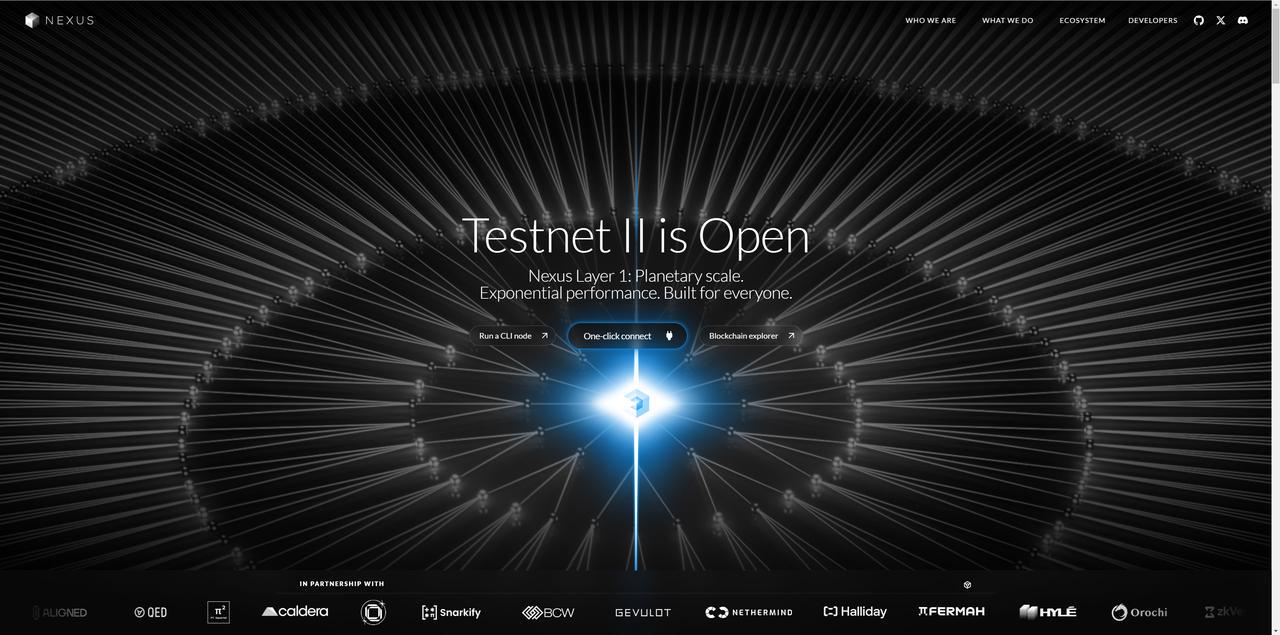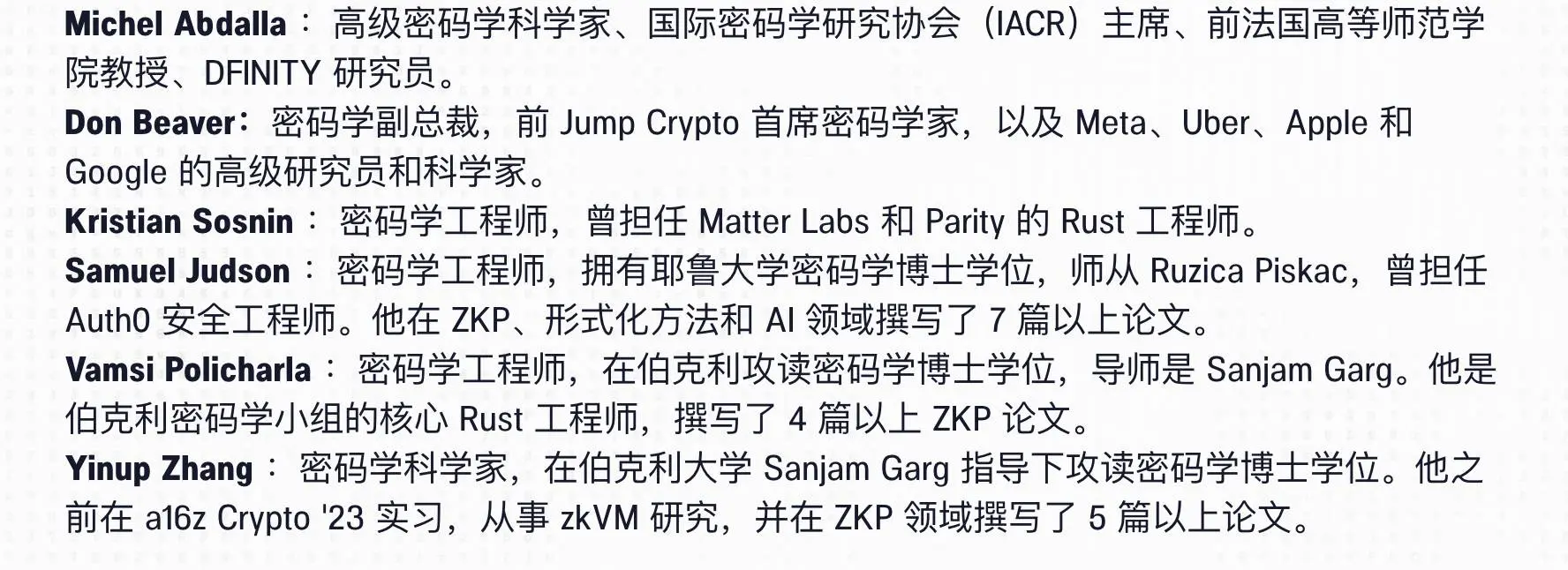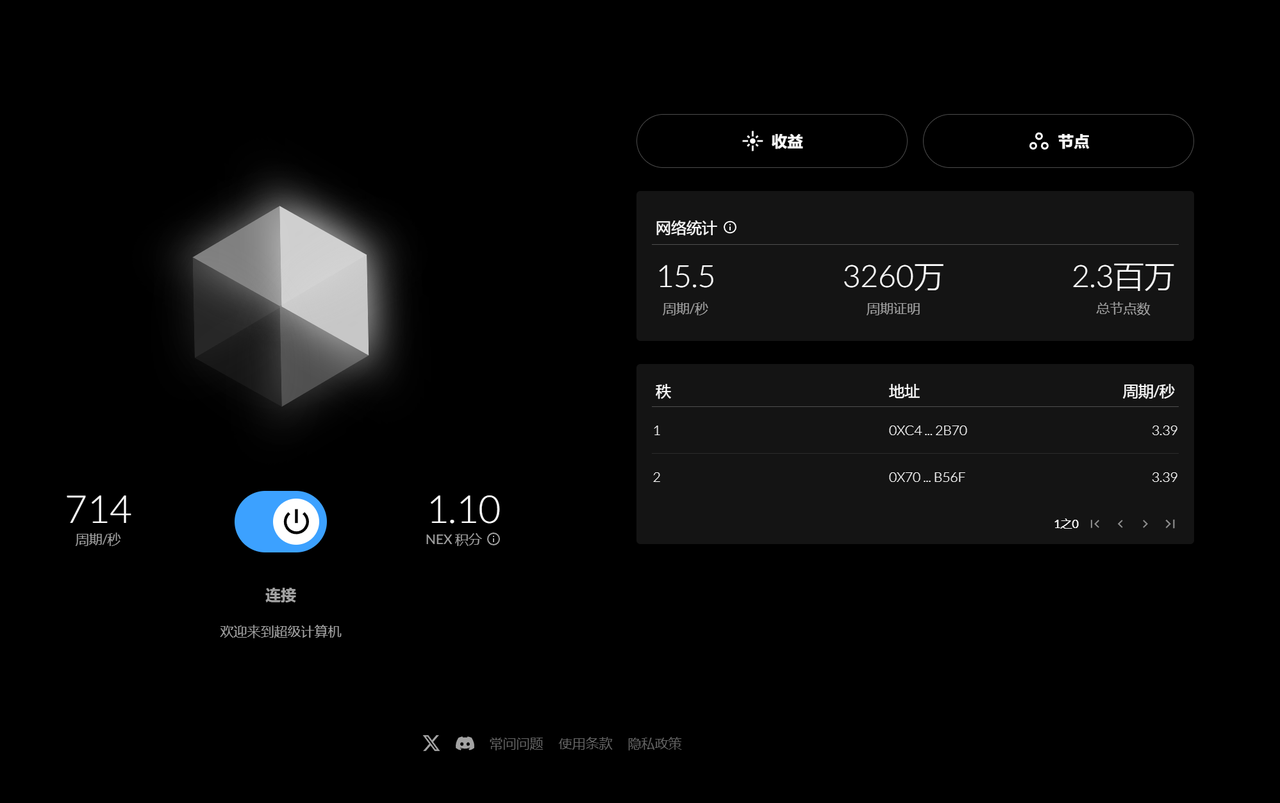No.: PandaLY Hotspot Insights Broadcast No.012
Nexus is an innovative project with high-performance blockchain technology at its core. It focuses on the "web-side CPU mining" (i.e. "CPU head mining") model, which aims to lower the threshold for mining and attract ordinary users to directly participate in computing power contribution through the browser. At the same time, it combines decentralized finance (DeFi) and distributed artificial intelligence (AI) ecology. The ultimate goal of Nexus is to compress all verifiable calculations into a single proof, integrate millions of chains with applications to create a unified world computer.
Its core advantages include:
High concurrent processing capability: Nexus public chain claims to be able to process more than 3,000 transactions per second, far exceeding the throughput of Ethereum and meeting large-scale commercial needs.
Integration of Web3.0 and mining: Through the web mining model, users can participate without professional equipment, greatly expanding the user base. It is similar to Grass (distributed computing power network), but emphasizes low thresholds and immediate returns.
Decentralized financial optimization: built-in oracle, native Swap and other functions, targeted optimization of DeFi scenarios, aiming to replace traditional centralized financial infrastructure.

Project Vision and Technical Highlights
Project Vision: NEXUS is committed to "connecting the decentralized world" and has built a global computing resource pool to integrate global computing resources, achieve cross-chain interoperability, and provide developers with an efficient serverless platform similar to traditional cloud computing (such as AWS Lambda).
Technical highlights: The project is based on Nexus zkVM technology, combining on-chain and off-chain computing methods, aiming to lower the development threshold and ensure system security and data immutability. It uses cutting-edge technologies such as zero-knowledge proof, off-chain computing, and multi-party computing to ensure low cost, high security, and high scalability.
Development status: The project recently announced the launch of a new blockchain based on Layer 1, and has gradually opened test networks (such as Nexus Testnet II). The detailed architecture and roadmap will be announced in the next few weeks. In addition, the team will open Nexus Testnet II on February 18, 2025, and the test network will be open until February 21, 2025. The goal of Testnet II is to prepare for the integration of the Nexus Layer 1 blockchain.
Nexus background: A combination of industry, academia and research led by top scholars + top capital support
Key team members:
CEO Daniel Marin: Stanford graduate, International Physics Olympiad medalist, active Github developer, solid technical background.
Consultant Dan Boneh: Professor of Cryptography at Stanford and member of the U.S. National Academy of Engineering, provides academic authority endorsement for the project.
Executive Team: The other core members of Nexus are also composed of a highly professional cryptography team, and have extensive experience in the Web3 industry, including work experience in multiple organizations such as Difinity, Jump Crypto, Matter Labs, and a16z training camp.

Financing scale:
The Nexus project has attracted a lot of capital in its early stages. According to public information, the project has completed a Seed round of financing of approximately US$2.2 million and received approximately US$25 million in the A round, bringing the total financing amount to approximately US$27.2 million.
Top capital endorsement:
Investors include well-known institutions such as Pantera Capital, Lightspeed Venture Capital, Dragonfly Capital, Alliance DAO, Faction, SV Angel and Blockchain Builders Fund, which shows that the capital market has a high recognition of the project's technology and business model.
Nexus Airdrop and Participation Process
Currently, Nexus Network is in the initial Beta testing phase, and users can participate in mining through the official website (https://beta.nexus.xyz/). Participation methods include connecting to Nexus Network using a web application or command line interface. It should be noted that there is no need to bind a wallet at this stage, and it is not clear whether there will be rewards, which is a blind mining stage. Therefore, it is recommended that users do not clear the browser cache during the participation process to prevent the loss of points.
For users interested in participating in mining, it is recommended to follow the steps below:
Step 1: Visit the Nexus official website
Step 2: Click the “Connect” button to connect and start mining.
Step 3: Keep the page open and avoid refreshing or closing it to continue mining.

Please note that mining speed is related to computer configuration. Stronger devices will achieve higher mining efficiency and benefits. In addition, ensure that the network connection is stable to avoid affecting mining efficiency due to disconnection or lag.
For more information and latest updates, you can follow Nexus’ official Twitter account or visit its official website.
*PandaLY safety tips: Be sure to participate through official channels and beware of phishing links.
The next grass? Competitive analysis
Project Advantages Comparison:
Dimensions | Nexus | Grass | Traditional financial public chains (such as Solana, Ethereum) |
User threshold | Direct mining on the web page, zero hardware cost | Need to install client, depends on network bandwidth | Need to pledge and run nodes, the threshold is high |
Mining Mode | Device-free mining (web-based), combined with zkVM | Distributed GPU/CPU computing power sharing | Reliance on PoS or PoW |
Technology Positioning | Financial public chain + AI integration | Distributed computing network | Ethereum is centered on smart contracts, while Solana is centered on high-performance DeFi |
Ecosystem Expansion | Built-in DeFi tools, developer-friendly | Focus on computing resource sharing | Leaning towards financial ecology, strong versatility |
Security | zkVM + decentralized storage + smart contracts | Focus on the security of computing power scheduling | Reliance on L1 or L2 solutions |
Nexus lowers the threshold for participation through a web mining model. Compared with the high requirements of Grass and Solana, ordinary users can contribute computing power and receive incentives without professional hardware.
The technical positioning is more inclined towards the integration of finance and computing, while Grass is more focused on decentralized computing power trading, and Solana/Ethereum is centered on the financial ecosystem.
The ecosystem has strong scalability, optimizes smart contract execution through zkVM technology, is compatible with AI computing and DeFi applications, and forms a more comprehensive Web3 computing infrastructure.
Market awareness: Grass has accumulated a stable user base, and Nexus needs to quickly break out of the circle through a differentiated mining model.
Nexus Security Analysis:
Nexus web mining has built a mining network that is both technically in-depth and user-friendly through the three core highlights of efficient integration of zero-knowledge proofs, decentralized parallel computing, and low-threshold user experience. However, it is currently only in the testing phase, and the project's core technology and security have not yet been verified on a large scale in the market. In addition, web mining has higher requirements for technical security.
Especially in the Web3 field, security has always been one of the key factors that determine the life and death of a project, especially for decentralized computing networks like Nexus, which involve multiple aspects such as smart contracts, mining security, and user privacy. Issues such as its reliance on centralized script deployment and the fact that some codes are not fully open source still require continued attention.
Potential risks:
Code security and vulnerabilities: If there are vulnerabilities or backdoors in the web mining code, hackers may exploit them to perform malicious operations; at the same time, the project's node software may also face vulnerability risks.
Data privacy issues: Users may need to provide email and other information during the mining process, and data transmission and storage security must be ensured.
Phishing and counterfeiting risks: Due to the high market popularity of mining projects, counterfeit websites or phishing attacks may appear, and users may be easily deceived.
Resource abuse and performance impact: Leaving the browser idle for a long time may cause the user's device to overheat and increase power consumption. If malicious code is implanted, it may evolve into a "cryptojacking" (hijacking computing resources) attack.
Safety recommendations and protective measures:
Code audit and vulnerability scanning: It is recommended to conduct a comprehensive security audit of the Nexus mining front-end code and node deployment software to promptly discover and fix security vulnerabilities.
Data encryption and transmission security: Ensure that user data uses encryption protocols such as HTTPS during transmission to prevent man-in-the-middle attacks.
User education and risk warnings: Clearly disclose the risks of the testing phase to users, and recommend that users use independent devices or virtual machines for trial runs to prevent resource abuse caused by malware.
Multi-layer protection architecture: For node deployment, it is recommended to use security measures such as firewalls and intrusion detection systems (IDS) to protect the server from external attacks
Conclusion
In the blockchain industry, technological innovation and ecological prosperity are often accompanied by security challenges. As an emerging Layer 1 blockchain, Nexus must face a series of security issues such as decentralized mining, smart contract vulnerabilities, governance security, and economic model stability while promoting the integration of global computing resources. Security is not only a technical issue, but also the lifeline of the long-term development of the Nexus ecosystem.
Security is not a one-time task, but a process of continuous optimization and iteration. If Nexus wants to become a new generation of high-performance public chain, it must focus on security and continuously strengthen its own defense capabilities to truly become the mainstay of the global decentralized computing network.














